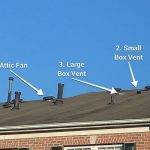Finding a leak can be tricky because water could be traveling from quite a distance. Before finding its way into your home it will typically travel through the roof layers, your attic and into your house.
5 Steps For Finding A Leak
1. Measure the location of the leak
- Measuring the location will enable you to find the entry point of the leak both in the attic and on the roof. This is important because all it takes is one small nail to cause a leak and there are thousands of nails holding your roof down.
- First, measure the distance of the center of the leak to two external walls of the house. Use this first measurement once you are inside the attic, to find the leak based off of the two external walls in the attic space.
- Second, measure the distance of the leak from the attic entrance. Use this second measurement to help you navigate the attic so that you can find the spot right above the wet drywall.
- Guessing the location without measurements is an easy way to completely miss the leak. Measuring the leak will give you peace of mind that you have found the exact spot.
2. Inspect the attic
- Once you’ve measured, you want to go into the attic and find the entry point of the leak. You are looking for water stains inside your attic on both the wood and insulation.
- Once you find the damp insulation, move it aside so you can see the leak from on top of the drywall, this will confirm the location.
- Then, follow the water stains on the wood above this point. The water stains might travel up a rafter and away from the home’s entry point. Keep following it till it stops. This will reveal to you the entry point from the roof, into the attic. You might see a rusty nail or the pipe flashing.
- Keep in mind that some water stains could be old and not related to your leak. This is why we measure the leak at all stages. Also, water stains could run along the pipes itself, so look for dried water marks on the pipes.
- At this point, you are looking at the underside of the plywood. You want to get a new set of measurements, which will help you once you are on top of the roof. Measure the distance of the leak between two walls, preferably the back and side wall. Remember that you need to measure at the angle of the roof line itself. An easy say to do this would be to count plywood, since one sheet of plywood is going to be 4 feet wide.
3. Always take pictures
- Pictures are extremely helpful both for when you are on the roof doing the inspection as well as for in the future if you are concerned the leak came back. This will help you get your bearings when standing on the roof, especially if your roof is large.
4. Look for daylight
- This method typically comes into play when inspecting a leak from a pipe. The flashing around the pipe could be damaged and allowing sunlight inside. So turn your light off once you are next to the pipe and look up at where it transitions out of the attic. You are looking for a sliver of light between the pipe and the flashing.
5. Inspect the roof
- Before heading up to your roof, make sure that you are familiar with the common structural parts of a roof and the different pipes and vents on your roof. Knowing what you’re looking at while you’re up there will make it easier to find potential sources for the leak.
- Use your measurements and picture to find your location on the roof that seems to be the entry point. Some leaks can be found with a simple visual inspection while others require the removal of roofing material. For example, a nail might be the cause of the leak but you might not see the nail because it’s under a shingle.
- Some leaks enter the attic at one point but actually enter through the singles at a different point. A leak might enter a shingle from an exposed nail three feet above the point of entry into the attic. The water will travel between the layers of roofing material until it finds an opening into the attic.
- Most leaks on a sloped roof won’t travel to the left or right more than three feet. So once you find the attic entry point, look to the right and left, three feet on either side and work your way up the roof till you find the roof entry point.
- Follow the rusty nails until they end. If your attic measurement leads you to a rusty nail, check the shingles above it till you find the highest point on the roof that has rust or damage.
Finding a flat roof leak can be a bit more complex, because there isn’t a clear path for the water to travel. So, we’ve written a separate guide to help find leaks on a flat roof, or you can check out this blog with a full roof inspection checklist to see what professionals look for.
More Tips To Help You Find A Leak
1. Trace the stain.
- If you are worried the leak isn’t fixed or that it may have come back. Take a pencil and trace the outer line of the stain on the ceiling. If it rains and the line grows past your mark, you have a leak.
2. Water test the roof
- If you’re having trouble pinpointing the exact entry point of the leak on the roof, try a water test. Take a hose on the roof and have someone inside the attic. Both of you get on the phone so you can communicate when you see water dripping.
- Start by spraying the hose in a similar fashion to rain, pointed at the lowest point of the roof section that’s applicable and working your way up. Hold each stage of the location you are spaying for at least two minutes to give adequate time for the water to get through the layers of roofing.
3. Lay down paper in your attic
- If you are having difficulty finding the leak while in the attic, try to lay down a large piece of paper under the area of suspect inside the attic. Using something like Christmas wrapping paper is a good option. Turn it upside down so the plain side is facing up. So that way when the water drips, you will see the water stains easier.
Learn More – What Pipe Collar Flashing Should You Use On Your Roof?
Once You’ve Found The Vent Pipe Leak: Get It Repaired!
Once you’ve found the vent pipe leak, it’s crucial to get it repaired as soon as possible. Delaying can lead to additional damage, unnecessary expenses, and even potential health risks. If you’re in Maryland, contact the experts at RoofPRO for a free roof inspection and quality roofing services to get your roof repaired the right way.
If you’re outside of the RoofPRO service area, you may want to read about how to install flashing around a vent pipe, so that you know what to expect when you contact your local roofing contractor.
How To Install Flashing Around A Vent Pipe
More Roof System Resources Worth Exploring
A leaking vent pipe often signals a weaker point in the roofing system — and knowing how each part fits helps you see the full picture. Start with our guide to the parts of a roof system to understand how all components — decking, underlayment, shingles, flashing, vents — work together. Next, check out how forms of ventilation differ: we explain gable, soffit & ridge vents and how they each contribute to airflow and attic health.
When you inspect a vent-pipe leak, you’ll find the culprit might relate to exhaust design or intake systems. For that reason our piece on ridge vents vs. attic fans gives you a clearer view of how hot-air escapes and how it ties back to structures like soffit & ridge vents. Don’t forget: even the smallest penetration can undermine your roof’s integrity. That’s why the article titled what you should know about pipes on your roof is a useful companion to your inspection checklist.
Ready for deeper hands-on guidance? Our two bonus reads will help you move from understanding to action. First, explore how to install flashing around a vent pipe to see step-by-step repair methods. Then review ice and water shields to understand added protection strategies beneath the surface. Use these resources together to not only detect leaks but also strengthen your roof and safeguard your home for the long term.




